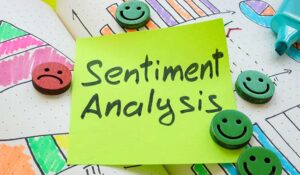Sentiment analysis and machine learning have become crucial tools for gauging the customer experience. Frequently used in contact centres to determine a customer’s emotion while behind their communication, sentiment analysis — driven by machine learning — has made its way into live chat platforms, writing and editing software, and more.
In the past, sentiment analysis was largely conducted by people. However, artificial intelligence tools and processes, like machine learning, have given sentiment analysis the ability to be more automated, saving companies time and providing instant insights into the direction their conversations are moving.
What is Machine Learning?
Machine learning is the technical process that happens behind the scenes to help computers and algorithms learn.
When a call centre uses sentiment analysis software to detect customer emotion as they speak with a representative, machine learning processes continuously monitor the conversation to learn more about what constitutes a positive or negative emotion.
People can train these algorithms to become better at doing what they do. Sentiment analysis platforms work behind the scenes during customer conversations, but humans can use tagging, alerts, and other tools to make the platform drill down elements of conversations the company wants to highlight. Similarly, data analysts can update and tweak machine learning systems for continued improvements.
Of course, with its advantages come a few disadvantages, as artificial intelligence has far to go to become perfect.
For instance, positive and negative tones can be exceptionally difficult for an algorithm to distinguish between. While most people understand sarcasm with verbal speech, machine learning models might view a sentence as positive when it was intended to be negative.
How Machine Learning and Sentiment Analysis Work Together
In terms of sentiment analysis, machine learning uses natural language processing (NLP) to learn and optimize a sentiment analysis system.
NLP is a type of computer science that mimics human communication in a digital form, allowing computers to understand what people say and what they mean when they say it.
Typically, sentiment analysis systems using machine learning are powered by deep learning models, which data scientists train to analyze conversations and provide quick insights to users.
These deep learning models are designed to pick up on many nuances of human speech, including tone, vocabulary, and sentence structure.
Think of machine learning as the brain of a good sentiment analysis tool, consistently thinking, learning, and improving itself to become more intelligent.
Companies can use this exciting technology to analyze everything from brand sentiment to how well the customer service team is taking care of customer needs.
4 Types of Machine Learning Methods for Sentiment Analysis
New machine learning methods continuously transform the way that AI shapes sentiment analysis. The following are a few popular machine learning techniques used for optimizing sentiment analysis software.
1. Support Vector Machine
Earlier machine learning models were often based on linear regression models that predicted an outcome using X features to determine a Y value. The models divided X and Y values along a line, also known as a plane, stating that Y is the result if X happens.
More recently, support vector machine (SVM) learning has become more prominent in sentiment analysis. Although it’s based on linear regression, it’s more advanced and complex, allowing AI to predict more accurate outcomes from the data features it studies.
2. Naïve Bayes
Naïve Bayes is a mathematical model that calculates the probability that a word or phrase is either positive or negative. It’s one of the most popular machine learning methods for sentiment analysis because of its simple classification abilities, allowing it to quickly determine a conversation’s overall sentiment.
3. K-Nearest Neighbor
K-Nearest Neighbor (KNN) is a popular classification system for text, which is why it works well with sentiment analysis. KNN uses labeled data—for sentiment analysis, labels are usually neutral, positive, and negative—to accurately label unlabeled data.
KNN is based on the idea that similar data points stay close to one another. Over time, this model can help determine what words and phrases are positive, negative, or neutral based on the data that exists around them.
4. Hybrid Machine Learning and Rules
Some sentiment analysis software solutions rely on rules rather than machine learning. Rule-based systems include and exclude specific words and phrases as positive or negative.
These systems usually work best with niche industries with frequently used jargon that can be difficult to abstract for typical machine learning models.
Hybrid models incorporate machine learning and rule-based systems, allowing both types of systems to work together for a more well-rounded approach toward sentiment analysis.
Companies using this approach might use a machine learning system to create rules or feed them into their machine learning system to help it evolve.
Frequently Asked Questions
Sentiment analysis isn’t the same as machine learning, but it does rely on machine learning methods to analyze human language and determine the meaning and overall feeling behind the spoken words.
Machine learning models are used to perform sentiment analysis. Machine learning models are trained using examples of human language and the sentiment behind them. After this training, sentiment analysis software leverages machine learning to analyze and score human language based on its prior training.
Sentiment analysis is one form of natural language processing (NLP). Sentiment analysis uses measures, analyzes, and scores human language to better understand the individual’s opinions and feelings about a topic.
The four main steps of sentiment analysis include:
1. Data Collection:
The first stage in the sentiment analysis process is collecting the data to be analyzed from one or more sources.
2. Data Processing:
After collecting the data to be analyzed, sentiment analysis solutions, such as conversation analytics, process the data, which essentially prepares it for analysis. This may mean transcribing spoken language, text extraction, and other data processing methods.
3. Data Analysis:
The data analysis stage involves multiple sub-steps, such as training the machine learning model with examples, adding custom tags to data, classifying data based on the overall theme or type of conversation, and then analyzing the data based on patterns and trends in the data and how they compare to the machine learning algorithm’s training data.
4. Data Visualization:
The final step in the sentiment analysis process is data visualization, or translating the raw data into actionable insights illustrated in charts, graphs, and other types of visualizations for easy understanding and application.
Using Machine Learning for Automated Sentiment Analysis
Machine learning is becoming more mainstream in businesses of all sizes and industries. Incorporating it into a sentiment analysis system can facilitate automation and accuracy, allowing companies to better understand how well they address their customers’ needs.
This blog post has been re-published by kind permission of CallMiner – View the Original Article
For more information about CallMiner - visit the CallMiner Website
Call Centre Helper is not responsible for the content of these guest blog posts. The opinions expressed in this article are those of the author, and do not necessarily reflect those of Call Centre Helper.
Author: CallMiner
Published On: 30th Jun 2023 - Last modified: 9th Dec 2024
Read more about - Guest Blogs, CallMiner






 CallMiner is the leading cloud-based customer interaction analytics solution for extracting business intelligence and improving agent performance across all contact channels.
CallMiner is the leading cloud-based customer interaction analytics solution for extracting business intelligence and improving agent performance across all contact channels. 


































